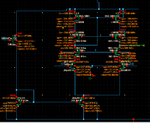MahmoudHassan
Full Member level 6

Hello
Dear All
I designed a telescopic Opamp to get high gain. The circuit is working good and the gain as shown is 65dB and all transistors are working in Saturation.
The main problem is in PSRR test:
What I did is adding 1V AC signal with VDD and using ADE in virtuoso
Results> Direct PLOT> AC DB20
The output is really strange as the PSRR is positive !
IS this test methodology is correct for PSRR?
Attached circuit, gain and PSRR figures




Dear All
I designed a telescopic Opamp to get high gain. The circuit is working good and the gain as shown is 65dB and all transistors are working in Saturation.
The main problem is in PSRR test:
What I did is adding 1V AC signal with VDD and using ADE in virtuoso
Results> Direct PLOT> AC DB20
The output is really strange as the PSRR is positive !
IS this test methodology is correct for PSRR?
Attached circuit, gain and PSRR figures









